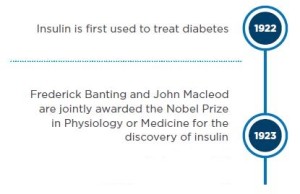Insulin: A Story of Innovation

Ninety-four years of development, and the future of insulin therapy
Fourteen-year-old Leonard Thompson was gravely ill, slipping in and out of a coma at Toronto General Hospital. He’d been diagnosed with diabetes three years earlier, and despite receiving the best treatment available, his condition had steadily worsened. Doctors offered a risky proposition: a promising but experimental drug they’d been developing but hadn’t yet used in people.
The year was 1922. One of the doctors was Sir Frederick Grant Banting, and the drug, of course, was insulin.
That day in 1922, Leonard became the first person to receive insulin. But instead of lowering his blood sugar, it caused an allergic reaction that sent Leonard’s doctors back to the lab, where they worked almost around the clock to improve the formulation. Almost two weeks later, they returned to Leonard’s bed with a new syringe: insulin 2.0. With this version, Leonard’s symptoms began to disappear and he regained his health.
 Insulin was a true breakthrough in diabetes care, and the reworking that made it an initial success set the stage for innovation that would continue throughout the next century. Animal-derived extracts would give way to ultrapure biosynthetic human insulins. Insulin concentration and delivery tools would be standardized to ensure accurate dosing. Insulin analogs with varying speed and duration of action would enable fine-tuning of glucose management. Pumps, pens and inhalers would be developed to customize insulin administration. Three Nobel Prizes would be awarded to scientists for their work with insulin, including Banting, whose birthday November 14 is now celebrated as World Diabetes Day.
Insulin was a true breakthrough in diabetes care, and the reworking that made it an initial success set the stage for innovation that would continue throughout the next century. Animal-derived extracts would give way to ultrapure biosynthetic human insulins. Insulin concentration and delivery tools would be standardized to ensure accurate dosing. Insulin analogs with varying speed and duration of action would enable fine-tuning of glucose management. Pumps, pens and inhalers would be developed to customize insulin administration. Three Nobel Prizes would be awarded to scientists for their work with insulin, including Banting, whose birthday November 14 is now celebrated as World Diabetes Day.
Banting’s spirit of ingenuity is alive and well at JDRF today, inspiring us to devise even better forms of the life-saving drug he first gave to Leonard Thompson.
Imagine insulin that waits on standby in your system all day, ready to respond to rising blood-glucose levels so you don’t have to. Imagine insulin that starts to work quickly and doesn’t hang around too long after your meal is over. Imagine insulin that packs a bigger punch so you can take a smaller dose. Imagine insulin pumps and other delivery systems that are smaller, safer, more comfortable and more convenient than today’s technologies. At JDRF, we are not just imagining the next generation of insulins—we are bringing them to life.
Why It Matters
The discovery of insulin revolutionized the treatment of T1D in 1922. But despite continual refinement since then, it’s still difficult for many people with T1D to keep their blood-glucose levels within a healthy range and to avoid overdosing. Through our Glucose Control Program, JDRF is looking at insulin in new ways to help people with T1D maintain healthy blood-sugar levels without a struggle.
Learn More
Glimpse the future of insulin via JDRF’s Glucose Control Program.